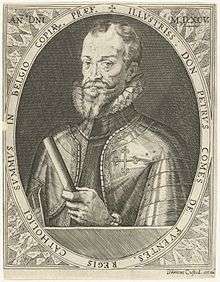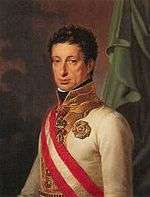List of governors of the Habsburg Netherlands
The Governor (Dutch: Landvoogd) or Governor-General (Gouverneur-Generaal) ruled the Habsburg Netherlands as a representative of the Dukes of Burgundy (until 1506), the Kings of Castile (1506-1598; 1621-1706), and the Archdukes of Austria (1716-1794).
List of Governors
| Picture | Name | Took office | Left office | Relationship to monarch | Monarch |
|---|---|---|---|---|---|
 |
Engelbert II of Nassau (1451-1504) |
1501 | 1504 | / | Maximilian I, Holy Roman Emperor for Philip I of Castile |
.jpg) |
William de Croÿ (1458-1521) |
1504 | 1507 | / | Charles V, Holy Roman Emperor |
 |
Margaret of Austria (1480-1530) |
1507 | 1 December 1530 (death) |
Aunt | |
%2C_Queen_of_Hungary.jpg) |
Mary of Austria (1505-1558) |
January 1531 | October 1555 | Sister | |
| In 1556, Philip V, Duke of Burgundy, became king of Spain as Philip II, thereby bringing the Habsburg Netherlands under Spanish control. | |||||
.jpg) |
Emmanuel Philibert of Savoy (1528-1580) |
1555 | 1559 | Cousin | Philip II of Spain |
 |
Margaret of Parma (1522-1586) |
1559 | 1567 | Half-sister | |
 |
Fernando Álvarez de Toledo (1507-1582) |
1567 | 1573 | / | |
.jpg) |
Luis de Requesens y Zúñiga (1528-1576) |
1573 | 5 March 1576 (death) |
/ | |
 |
John of Austria (1547-1578) |
1576 | 1 October 1578 (death) |
Half-brother | |
 |
Alexander Farnese (1545-1592) |
1578 | 3 December 1592 (death) |
Half-nephew | |
 |
Peter Ernst I von Mansfeld-Vorderort (1517-1604) |
1592 | 1594 | / | |
 |
Ernest of Austria (1553-1595) |
1594 | 20 February 1595 (death) |
Nephew | |
 |
Pedro Henriquez de Acevedo (1525-1610) |
1595 | 1596 | / | |
 |
Albert of Austria (1559-1621) |
1596 | 1598 | Nephew | |
| In 1598, Philip II of Spain ceded the Netherlands to his daughter Isabella Clara Eugenia and nephew Albert, who married the next year. They reigned together until his death, when the Netherlands passed to their nephew, Philip IV of Spain, in whose name Isabella Clara Eugenia governed the countries until her death. | |||||
 |
Isabella Clara Eugenia of Austria (1566-1633) |
1621 | 1 December 1633 (death) |
Aunt | Philip IV of Spain |
 |
Ferdinand of Austria (1609/1610-1641) |
1633 | 9 November 1641 (death) |
Brother | |
 |
Francisco de Melo (1597-1651) |
1641 | 1644 | / | |
 |
Manuel de Moura (1590-1651) |
1644 | 1647 | / | |
 |
Leopold William of Austria (1614-1662) |
1647 | 1656 | Cousin | |
 |
John of Austria the Younger (1629-1679) |
1656 | 1659 | Son | |
 |
Luis de Benavides Carrillo (1608-1668) |
1659 | 1664 | / | |
 |
Francisco de Moura (1610-1675) |
1664 | 1668 | / | |
| Charles II of Spain | |||||
| |
Íñigo Melchor de Velasco (1608-1668) |
1668 | 1670 | / | |
 |
Juan Domingo de Zuñiga y Fonseca (1640-1716) |
1670 | 1675 | / | |
 |
Carlos de Aragón de Gurrea (1634-1692) |
1675 | 1677 | / | |
 |
Alexander Farnese (1635-1689) |
1678 | 1682 | Distant relative | |
| Ottone Enrico del Caretto (1629-1685) |
1682 | 1685 | / | ||
 |
Francisco Antonio de Agurto (1640-1702) |
1685 | 1692 | / | |
 |
Maximilian II Emanuel of Bavaria (1662-1726) |
1692 | 1706 | Nephew-in-law | |
| Uncle | Philip V of Spain | ||||
| Following the War of the Spanish Succession, Holy Roman Emperor Charles VI became ruler of the Austrian Netherlands. | |||||
| |
Eugene of Savoy (1663-1736) |
1716 | 1724 | Distant relative | Charles VI, Holy Roman Emperor |
 |
Wirich Philipp von Daun (1669-1741) |
February 1725 | October 1725 | / | |
 |
Maria Elisabeth of Austria (1680-1741) |
1725 | 26 August 1741 (death) |
Sister | |
| Aunt | Maria Theresa of Austria | ||||
 |
Friedrich August von Harrach-Rohrau (1696-1749) |
1741 | 1744 | / | |
 |
Maria Anna of Austria (1718-1744) |
1744 | 16 December 1744 (death) |
Sister | |
 |
Charles Alexander of Lorraine (1712-1780) |
4 July 1780 (death) |
Brother-in-law | ||
 |
Maria Christina of Austria-Lorraine (1742-1798) with Albert Casimir of Saxony (1738-1822) |
1781 | 1793 | Sister and brother-in-law | Joseph II, Holy Roman Emperor |
| Leopold II, Holy Roman Emperor | |||||
| Aunt and uncle | Francis II, Holy Roman Emperor | ||||
 |
Charles of Austria-Lorraine (1771-1847) |
1793 | 1794 | Brother | |
Thereafter, the French revolutionaries occupied the Low Countries until 1815. The Emperor formally recognized the loss of these territories by the Treaty of Lunéville of 1801. At the Congress of Vienna, in 1815, the Low Countries were re-united in a personal union under the House of Orange-Nassau. In 1830, Belgium declared its independence.
See also
This article is issued from
Wikipedia.
The text is licensed under Creative Commons - Attribution - Sharealike.
Additional terms may apply for the media files.